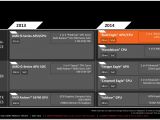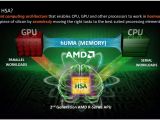Since the embargo has finally lifted, we can share with you the information provided to us by Advanced Micro Devices on the Radeon R-Series of embedded central/accelerated processing units.
Embedded APUs might not sound like such an exciting topic, but when you think about how many different machines are used in all levels of the industry, you realize that AMD stands to make a lot of money if it scores contracts.
After all, the fields of medical imaging, digital signage, IC&A (industrial control and automation) and gaming machines aren't getting any smaller. That's what the latest R-Series chips are for.
The second generation R-Series APUs and CPUs from Advanced Micro Devices promise to deliver significant performance advantages over competing Intel solutions (Haswell Core-i CPUs supposedly).
More specifically, they claim to be up to 44% better at drawing 3D graphics, and capable of delivering up to 46% more compute performance too.
Meanwhile, when pitted against the first generation R-Series chips, the Bald Eagle processors are up to 55% and 66% better, respectively.
All in all, not bad for processors with 2.2 GHz to 3.6 GHz CPU frequency (Steamroller architecture) and 533 MHz to 686 MHz GPU clock.
And yes, the GPUs are indeed based on the latest AMD Graphics Core Next (GCN) architecture, which enable both visual performance and parallel processing capabilities.
Largely, the performance advantages of the R-Series embedded chips are owed to the Heterogeneous System Architecture (HSA). They're the first embedded chips featuring this actually.
Moreover, the newcomers boast DDR3-2133 MHz memory support with ECC (error correcting code) and configurable TDPs.
Finally, open-source Linux development and commercial support is provided to all customers, through Mentor Embedded Linux and Sourcery CodeBench, plus Mentor Embedded Linux Lite (available at no cost).
It is AMD's intention to ship the chips alone or in a pair, of sorts, with the AMD Embedded Radeon E8860 discrete GPU. Such a combo would allow digital signage display arrays of up to nine panels and 4K resolution.
Portable, 3D and 4D ultrasound, low-dose X-ray, and imaging-assisted surgical systems were specifically mentioned in AMD's presentation as well. Here, hUMA proves most beneficial, as it lets both the CPU and GPU cores access memory directly.
As for Communications and Networking Infrastructures, they will benefit from the parallel computing assets of the R-Series units.
"When it comes to compute performance, graphics performance and performance-per-watt, the 2nd generation AMD Embedded R-series family is unique in the embedded market," said Scott Aylor, corporate vice president and general manager, AMD Embedded Solutions.
"The addition of HSA, GCN and power management features enables our customers to create a new world of intelligent, interactive and immersive embedded devices."

 14 DAY TRIAL //
14 DAY TRIAL // 


